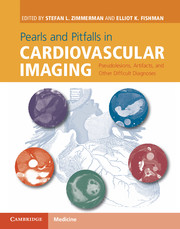 Pearls and Pitfalls in Cardiovascular Imaging
Pearls and Pitfalls in Cardiovascular Imaging from Section 1 - Cardiac pseudotumors and other challenging diagnoses
Published online by Cambridge University Press: 05 June 2015
Imaging description
Left atrial appendage pseudothrombus is not uncommonly encountered in patients with left atrial enlargement and poor atrial function. In this entity, stasis of blood in the left atrium results in incomplete mixing, or underfilling, of nonopacified blood in the left atrial appendage with intravenous contrast. The result is a low-attenuation region in the tip of the appendage that can be mistaken for thrombus (Figure 6.1). At transesophageal echocardiography, the gold standard for evaluation of left atrial appendage thrombus, underfilling of the left atrial appendage on CT, usually corresponds to spontaneous echo contrast, a sign of blood stasis, with or without thrombus.
Importance
Left atrial pseudothrombus is relatively common in patients with atrial fibrillation who undergo cardiac CT for preablation mapping. In a large study of 402 atrial fibrillation patients with 64-slice contrast enhanced CT, underfilling of the left atrial appendage was seen in 40 (10%), with nine of these patients having true thrombus detected by transesophageal echocardiography. The remaining patients had spontaneous echo contrast. Left atrial underfilling is also important to recognize in patients with a history of stroke, who may have emboli originating from the left atrium. If underfilling is recognized at the time of imaging, acquisition of additional delayed images can improve differentiation of thrombus from blood stasis (Figure 6.1). Distinction of true left atrial thrombus from pseudothrombus is critical as ablation procedures should not be performed in the presence of thrombus, due to the risk of clot dislodgement and distal embolization during the procedure. Incorrect diagnosis of thrombus can result in unnecessary delay of ablation therapy and risks of anticoagulation medications.
Typical clinical scenario
Left atrial pseudothrombus can be seen in any patient, but is most commonly encountered in patients with dilated, poorly functioning atria. These patients have poor mixing of blood in the left atrial appendage due to stasis. Unfortunately, these same characteristics also put the patients at high risk for true left atrial thrombus, increasing the challenge of diagnosis.
To save this book to your Kindle, first ensure [email protected] is added to your Approved Personal Document E-mail List under your Personal Document Settings on the Manage Your Content and Devices page of your Amazon account. Then enter the ‘name’ part of your Kindle email address below. Find out more about saving to your Kindle.
Note you can select to save to either the @free.kindle.com or @kindle.com variations. ‘@free.kindle.com’ emails are free but can only be saved to your device when it is connected to wi-fi. ‘@kindle.com’ emails can be delivered even when you are not connected to wi-fi, but note that service fees apply.
Find out more about the Kindle Personal Document Service.
To save content items to your account, please confirm that you agree to abide by our usage policies. If this is the first time you use this feature, you will be asked to authorise Cambridge Core to connect with your account. Find out more about saving content to Dropbox.
To save content items to your account, please confirm that you agree to abide by our usage policies. If this is the first time you use this feature, you will be asked to authorise Cambridge Core to connect with your account. Find out more about saving content to Google Drive.